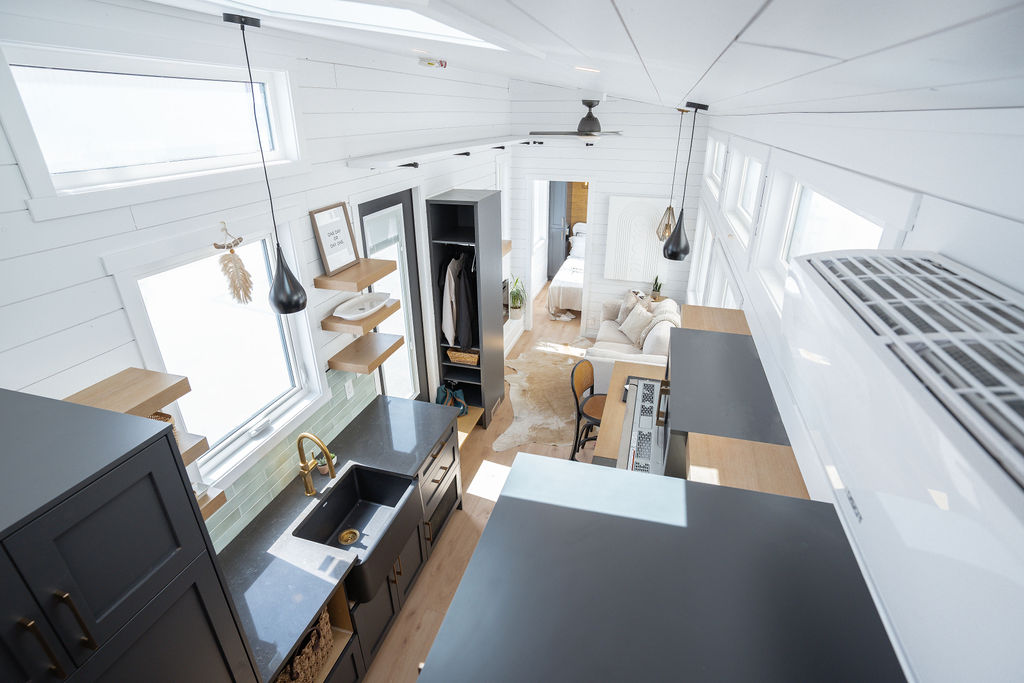Move over THOW, there's a Foundation Build in Town!
Jun 21, 2023
Picture this.
You wake up in the main floor bedroom of your tiny home. Stepping out of bed you slip on your slippers and pad to the kitchen to start your morning coffee.
Moving into the bathroom you splash some water on your face and look out of the bay front windows lining your vanity countertop into the beautiful yard around you.
Heading back to the kitchen you pour your carefully brewed coffee into your favorite mug and step out on your deck (!!) taking in the crisp morning air. You place your coffee on your patio table and step down to give your garden it's morning watering.
Are you envisioning it?
Tiny home dreams aren't just for the nomad's of the tiny home movement.
Have you always wanted to meander down the driveway to your dream home, but felt like a tiny home on wheels wasn't the right fit for you?

Well, we've got the perfect solution.. a tiny home from the Teacup Foundation Series.
Now I bet you're thinking, wow - a tiny home on a foundation, that sounds perfect! But.. what are the steps?
STEP ONE
Unlike a THOW, your foundation builds location is going to be your biggest step and should be what you work on first.
Where do you want to spend your days? The backyard of your current home (consider renting the main house for additional income), a plot of land that you own, or a long term lease on someone else's property. Once you've got a location in mind, you'll need to review local zoning regulations pertaining to tiny homes. These regulations will dictate whether tiny homes are allowed or if there are any specific requirements/restrictions that you need to consider.
If you are located in Ontario, Bill 23 mandates that a minimum dwelling square footage be 188 sq. ft. across the province, which makes the decision making process simpler.
STEP TWO
Your next step is choosing a manufacturer. Trusting a company like Teacup ensures that you are in compliance with local building codes and regulations. We build our foundation series homes to meet CSA A277 of Z240-MH and collaborate with certified partners to ensure that your tiny home will adhere to the building code specific to your location. Regardless of which manufacturer you choose make sure they will provide you with blueprints, building specifications,, and engineering support to facilitate the process.
Once you've chosen a manufacturer, you'll need to obtain a land survey. This survey ensures that you are in compliance with setbacks, easements, and other land-related considerations. You will also need to have a plot plan created and submitted to the municipality as part of the permitting process. To complete the permit process you'll need to compile all of your necessary documentation - including plans, foundation plans, surveys, and any other required paperwork and submit them to your local building department.

Permit approval timelines can take a few days to a few weeks, depending on the jurisdiction. During the permitting process it's crucial to arrange your finances. Seek financing options through your bank or credit union, specifically ask for a construction loan. A construction loan will enable you to access funds in stages to cover the site installation team and the manufacturers costs.
STEP THREE
The final step of your foundation tiny home journey is the most exciting! This is where you prepare your site for the installation of your tiny home, which can include grading, preparing the foundation, and arranging utility connections.
The build of your tiny home actually happens! Choosing Teacup means you'll have access to the Teacup Academy - an online portal filled to the brim with all of the information you'll need about the build process and helpful videos to guide you after you've received your home. You'll also get access to the team through our project management app and transparency through the build with photo updates and zoom walk throughs!
Once the home is complete you'll need to coordinate delivery of the home to your installation site, which could involve a crane to carefully offload the tiny home from a truck. In cases where you're adding a secondary suite to an established neighborhood, craning over existing structures may be necessary.

Installing your manufactured tiny home onto the site should be handled by certified trade professionals to connect plumbing, sewer, gas, and electrical connections. Also be sure to adhere to CSA codes when skirting your tiny home to ensure you're in compliance! You'll also need to schedule inspections as required by the building department and obtain your final approval from your local building department. You'll also need to make sure you receive your occupancy permit before officially moving into your tiny home.
Once you've received your occupancy permit you'll be able to walk into your dream tiny home, know that you've changed the course of your life, and be able to start living how you want to.
If you feel like you are ready to chat about your tiny home journey, book a discovery call with our team. They'd love to walk you through the steps and hear about your dreams.
Not quite ready to take that leap? Keep learning! Follow us on Instagram and Facebook.
Until next time,
-Jen

